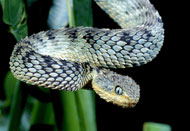Description:
This venomous, pretty, rough-scaled, arboreal viper is also known as the common bush viper and the green bush viper. Since the species is remarkably polymorphic, occurring also in reds, oranges, grays, yellows, black, blues, olive, and various shades of brown, as well as green, all with or without darker or lighter crossbands, the name of green bush viper is notably inaccurate. Providing they have not been seriously dehydrated or otherwise mishandled during capture and transport, the variable bush viper is a hardy animal. As with any wild-collected frog eating snake, a stool sample should be analyzed for endoparasites and if necessary an eradication protocol should be adopted. Follow your veterinarian’s advice. Adult captives usually readily accept prekilled mice. Neonates may be more difficult to entice to feed, but scenting a pinky mouse with a frog and offering it on long forceps often works. Atheris squamiger is able to move quickly when necessity dictates, but in general this taxon is inactive to the point of lethargy. They will find a quiet elevated perch in their terrarium, coil, and may remain, barely moving, for several days. But, if disturbed, they can and will strike quickly and accurately. Human fatalities have been attributed to envenomation by this viper. Because they are a fairly small and very inactive snake, a relatively small terrarium will suffice for their husbandry. A vertically oriented terrarium of 15 or 20 gallon capacity is large enough for a pair or trio of adults. With a secure and sturdy climbing limb or two (preferably with comfortable forks), elevated corkbark hides, and a hardy live plant (such as an Epipremnum [Pothos]) a beautiful and very usable terrarium setup can be designed. Most bush vipers will drink readily from a water dish on the bottom of the cage but some may have difficulty recognizing this as the drinking source. It may be necessary to elevate the water bowl and roil the surface of the water with an aquarium air stone attached to a small vibrator pump. A daytime temperature of 80 to 82 degrees Fahrenheit (with a hot spot of about 85 degrees) and a nighttime temperature of 75 degrees is satisfactory. A screen top to allow air circulation is better than a glass one. Reproductive cycling is begun by dropping the cage temperatures a few degrees and lowering the relative humidity for a few weeks. When the temperature and humidity is again elevated breeding often takes place. Passing storms that lower barometric pressure are also helpful in inducing breeding. A clutch contains 3 to 11 neonates.
Habitat:
The variable bush viper is most often associated with rainforests, but occurs also in open woodlands, along water courses and in the vegetation bordering trails.
Range:
This is an abundant forest bush viper from Nigeria to western Kenya. It also is found from northwestern Tanzania southward to northwestern Angola, as well as on the Island (formerly Fernando Po).
Scientific Name: Atheris squamiger
Species Group: venomous
Family: Viperidae
Size: At an adult length of 16 to 22 inches, males are the smaller sex. Females vary from 20 to 28 inches in length but have been authenticated at 32 inches.
Level: advanced
Weight:
Dangerous: No



